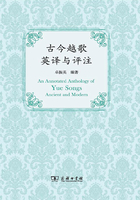
Comments and Annotations
Liu Sanjie, also known as Liu Sanmei (刘三妹), was a renowned songstress of the Zhuang Nationality (壮族), who is said to have lived in the Reign of Zhongzong (唐中宗) of the Tang Dynasty (618—907). For her great accomplishments she has been posthumously honored as Fairy of Songs, about whom legends abound.
The earliest records about Liu are offered in The Encyclopedic Chorography (《舆地纪胜》) compiled by Wang Xiangzhi (王象之, 1163-1230), a celebrated scholar from Wuzhou (婺州, the present Jinhua of Zhejiang Province). Many of Liu’s songs are included in The Folk Songs of Yue: in the Wake of the Nine Hymns (《粤风续九》), which is compiled by Wu Qi (吴淇), Zhao Longwen (赵龙文) et al. For more information about the life and deeds of Liu Sanjie, please refer to Appendix III.
For ages Liu’s songs have enriched people’s life, enabled people to stay sane in face of disasters, and aroused people’s resistance against suppression and exploitation. To cherish their memory of the Fairy of Songs, the people of Guangxi and Guangdong have built memorial temples in her honor, and people of the Zhuang Nationality in Guangxi observe the Festival of Songs every year on the third of the third lunar month.
The present song, taken from the 11th page of The Folk Songs of Yue: In the Wake of the Nine Hymns, encourages the young people to hold their fate in their own hands and to pursue their happiness while they are young.
In the old society, free love was forbidden, and it was the parents that had a say about their children’s marriages. The progressive idea of the song is laudable, and equally so is its artistry. Just as is pointed out by the authors of the above-mentioned book, “it is so touchingly beautiful in language and so freshly succinct in style that the value of each word in it is worthy of a thousand tael of gold.”